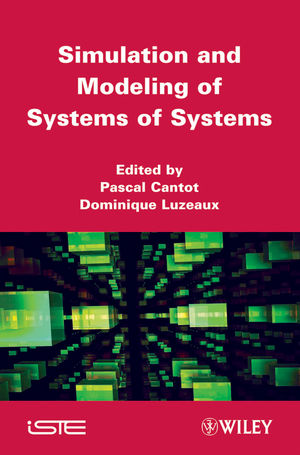Simulation and Modeling of Systems of SystemsISBN: 978-1-84821-234-3
Hardcover
400 pages
May 2011, Wiley-ISTE
 |
||||||
Introduction xi
Chapter 1. Simulation: History, Concepts, and Examples
1
Pascal CANTOT
1.1. Issues: simulation, a tool for complexity 1
1.2. History of simulation 14
1.3. Real-world examples of simulation 24
1.4. Basic principles 29
1.5. Conclusion 51
1.6. Bibliography 52
Chapter 2. Principles of Modeling 57
Pascal CANTOT
2.1. Introduction to modeling 57
2.2. Typology of models 58
2.3. The modeling process 66
2.4. Simulation project management 91
2.5. Conclusion 94
2.6. Bibliography 94
Chapter 3. Credibility in Modeling and Simulation
99
Roland RABEAU
3.1. Technico-operational studies and simulations 99
3.2. Examples of technico-operational studies based on simulation tools 101
3.3. VV&A for technico-operational simulations 102
3.4. VV&A issues 108
3.5. Conclusions 145
3.6. Bibliography 152
Chapter 4. Modeling Systems and Their Environment
159
Pascal CANTOT
4.1. Introduction159
4.2. Modeling time 160
4.3. Modeling physical laws 163
4.4. Modeling random phenomena 166
4.5. Modeling the natural environment 178
4.6. Modeling human behavior 193
4.7. Bibliography 203
Chapter 5. Modeling and Simulation of Complex Systems:
Pitfalls and Limitations of Interpretation 207
Dominique LUZEAUX
5.1. Introduction 207
5.2. Complex systems, models, simulations, and their link with reality 209
5.3. Main characteristics of complex systems simulation 218
5.4. Review of families of models 228
5.5. An example: effect-based and counter-insurgency military operations 244
5.6. Conclusion 246
5.7. Bibliography 249
Chapter 6. Simulation Engines and Simulation Frameworks
253
Pascal CANTOT
6.1. Introduction 253
6.2. Simulation engines 254
6.3. Simulation frameworks 260
6.4. Capitalization of models 290
6.5. Conclusion and perspectives 291
6.6. Bibliography 292
Chapter 7. Distributed Simulation 295
Louis IGARZA
7.1. Introduction 295
7.2. Basic mechanisms of distributed simulation 305
7.3. Main interoperability standards 312
7.4. Methodological aspects: engineering processes for distributed simulation 326
7.5. Conclusion: the state of the art: toward “substantive” interoperability 331
7.6. Bibliography 331
Chapter 8. The Battle Lab Concept 333
Pascal CANTOT
8.1. Introduction 333
8.2. France: Laboratoire Technico-Opérationnel (LTO) 336
8.3. United Kingdom: the Niteworks project 350
8.4. Conclusion and perspectives 351
8.5. Bibliography 352
Chapter 9. Conclusion: What Return on Investment Can We
Expect from Simulation? 355
Dominique LUZEAUX
9.1. Returns on simulation for acquisition 355
9.2. Economic analysis of gains from intelligent use of simulations 357
9.3. Multi-project acquisition 367
9.4. An (almost) definitive conclusion: conditions for success 368
9.5. Bibliography 371
Author Biographies 373
List of Authors 375
Index 377



